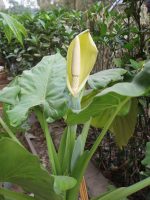 For gorgeous foliage and a tropical look even in USDA Zone 4, try growing the tender perennial elephant ear. The gigantic upward pointing leaves are 3-6 feet long and carried on long stems. The blades are ruffled, have prominent veins, and may be medium green, green tinged with purple or almost black, depending on the cultivar. The plant grows about 12′ high so serves as a shrub in the garden. While the leaves are the main attraction the yellowish-green flowers are very interesting and deserve some attention. They appear throughout the growing season, and are small and are carried together on a 8-10″ long club-like structure called spadix that is partially enclosed by a leafy bract called a spathe. Also called giant taro, the rhizome and shoots of the plant are edible if cooked properly but may may cause stomach problems if eaten without cooking and proper preparation. In addition, the sap can cause skin irritation. In its native habitat, the plant grows in the understory and along streams so is a good choice for a moist, shady spot but also does well in containers. Where grown as an annual, the rhizomes can be dug in the fall and stored in a cool, dry location until spring. Photo Credit Wikipedia
For gorgeous foliage and a tropical look even in USDA Zone 4, try growing the tender perennial elephant ear. The gigantic upward pointing leaves are 3-6 feet long and carried on long stems. The blades are ruffled, have prominent veins, and may be medium green, green tinged with purple or almost black, depending on the cultivar. The plant grows about 12′ high so serves as a shrub in the garden. While the leaves are the main attraction the yellowish-green flowers are very interesting and deserve some attention. They appear throughout the growing season, and are small and are carried together on a 8-10″ long club-like structure called spadix that is partially enclosed by a leafy bract called a spathe. Also called giant taro, the rhizome and shoots of the plant are edible if cooked properly but may may cause stomach problems if eaten without cooking and proper preparation. In addition, the sap can cause skin irritation. In its native habitat, the plant grows in the understory and along streams so is a good choice for a moist, shady spot but also does well in containers. Where grown as an annual, the rhizomes can be dug in the fall and stored in a cool, dry location until spring. Photo Credit Wikipedia
 Type: Herbaceous perennial often grown as an annual
Type: Herbaceous perennial often grown as an annual
Height: 12′
Bloom Color: Yellowish-green; not showy
Bloom Time: Throughout the growing season
Size: 12’ H x 6’ W
Light: Partial shade
Soil: Fertile, humusy, moist, well-drained; tolerates occasional flooding.
USDA Hardiness Zones: 8-10
Photo Credit: Wikipedia